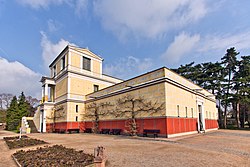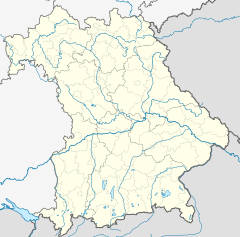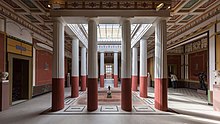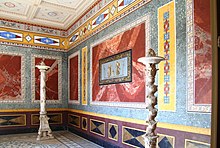
Aschaffenburg is a town in northwest Bavaria, Germany. The town of Aschaffenburg is not part of the district of Aschaffenburg, but is its administrative seat.

Neuschwanstein Castle is a 19th-century historicist palace on a rugged hill of the foothills of the Alps in the very south of Germany. It is located in the Swabia region of Bavaria, in the municipality of Schwangau, above the incorporated village of Hohenschwangau, which is also the location of Hohenschwangau Castle. The closest larger town is Füssen. The castle stands above the narrow gorge of the Pöllat stream, east of the Alpsee and Schwansee lakes, close to the mouth of the Lech into Forggensee.

The Englischer Garten is a large public park in the centre of Munich, Bavaria, stretching from the city centre to the northeastern city limits. It was created in 1789 by Sir Benjamin Thompson (1753–1814), later Count Rumford, for Prince Charles Theodore, Elector of Bavaria. Thompson's successors, Reinhard von Werneck (1757–1842) and Friedrich Ludwig von Sckell (1750–1823), advisers on the project from its beginning, both extended and improved the park.

Nuremberg Castle is a group of medieval fortified buildings on a sandstone ridge dominating the historical center of Nuremberg in Bavaria, Germany.

Linderhof Palace is a schloss in Germany, in southwest Bavaria near the village of Ettal. It is the smallest of the three palaces built by King Ludwig II of Bavaria and the only one which was actually completed and that he lived in most of the time from 1876.

The Befreiungshalle is a neoclassical monument on the Michelsberg hill above the town of Kelheim in Bavaria, Germany. It stands upstream of Regensburg on the river Danube at the confluence of the Danube and the Altmühl, i.e. the Rhine–Main–Danube Canal. It is just downstream of the Danube Gorge, towering above its lower end. It was commissioned by King Ludwig I of Bavaria to commemorate the victory over Napoleon in the Befreiungskriege of 1813–1815.

The Nymphenburg Porcelain Manufactory is located at the Nördliches Schloßrondell in one of the Cavalier Houses in front of the Nymphenburg Palace in Munich, Germany, and since its establishment in 1747 has produced porcelain of high quality. It is one of the last porcelain producers in the world where every single part is made entirely by hand.

Schloss Johannisburg is a schloss in the town of Aschaffenburg, in Franconia, in the state of Bavaria, Germany. It was erected between 1605 and 1614 by the architect Georg Ridinger for Johann Schweikhard von Kronberg, Prince Bishop of Mainz. Until 1803, it was the second residence of the Archbishop and Prince Elector of Mainz. It is constructed of red sandstone, the typical building material of the Spessart, the hills near Aschaffenburg.
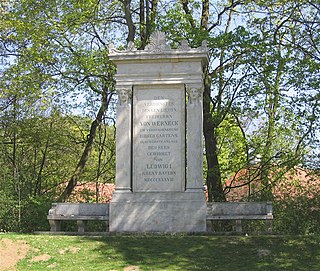
Reinhard Freiherr von Werneck was the successor of Benjamin Thompson in the management of the English Garden in Munich, Germany. During the six years that he held this office he was responsible for the creation of the Kleinhesseloher See and the addition of the Hirschau to the garden.

The Allerheiligen-Hofkirche is a Catholic church in the Munich Residenz designed by Leo von Klenze and built between 1826 and 1837.

Bergpark Wilhelmshöhe is a landscape park in Kassel, Germany. The area of the park is 2.4 square kilometres, making it the largest European hillside park, and second largest park on a hill slope in the world. Construction of the Bergpark, or "mountain park", began in 1689 at the behest of the Landgraves of Hesse-Kassel and took about 150 years. The park is open to the public today. Since 2013, it has been a UNESCO World Heritage Site because of its monumental Baroque architecture and its unique fountains and water features.
The Bavarian Administration of State-Owned Palaces, Gardens and Lakes, also known as the Bavarian Palace Department, is a department of the finance ministry of the German state of Bavaria. Tracing its roots back into the 18th century, the administration is now best known for being in charge of Neuschwanstein Castle and the other 19th-century palaces built by Ludwig II of Bavaria.
Events in the year 1886 in Germany.
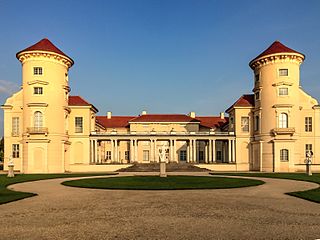
Rheinsberg Palace lies in the municipality of Rheinsberg, about 100 kilometres (62 mi) northwest of Berlin in the German district of Ostprignitz-Ruppin.

Residenz Ansbach, also known as Markgrafenschloss, is a palace in Ansbach, Germany. It was the government seat of the Margrave of Brandenburg-Ansbach. Today it is the administrative seat of the government of Middle Franconia. The Great Hall and the Orangerie in its garden serve as venues for the biennial music festival Bachwoche Ansbach.

Schönbusch is a historic park and Schloss near the town of Aschaffenburg in the Franconia region of Bavaria, Germany. The park was designed in the late 18th century as an English landscape garden for an Archbishop of Mainz. Various Neoclassical buildings, including the Schloss are scattered across the park. It is open to the public.

Schloss Seehof is a Schloss (palace) in Memmelsdorf, Bamberg, Germany. It was built from 1684 to 1695 as a summer residence and hunting lodge for Marquard Sebastian Schenk von Stauffenberg, Prince-bishop of Bamberg.
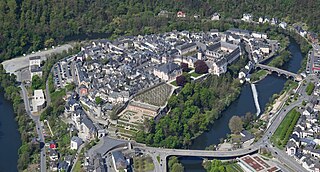
Schloss Weilburg is a Baroque schloss in Weilburg, Hesse, Germany. It is located on a spur above the river Lahn and occupies about half of the area of the Old Town of Weilburg. It contains the Hochschloss, built between 1530 and 1572, which is one of the best-preserved Renaissance palaces in Hesse. In the 1700s, the palace was expanded by John Ernst, Count of Nassau-Weilburg, and his builder, Julius Ludwig Rothweil. The buildings and gardens now belong to the Verwaltung der Staatlichen Schlösser und Gärten Hessen, and they can be visited as a museum on guided tours. Parts of the palace are venues for the music festival Weilburger Schlosskonzerte, which is named after the palace.
Events from the year 1863 in Germany.

Mergentheim Palace is a historic building located in Bad Mergentheim, Germany. The palace was first a castle, built in the early Middle Ages as the seat of the Taubergau, but then became a Teutonic possession in 1219, and then seat of the Mergentheim Commandery. The castle became the residence of the Grand Master of the Teutonic Order in 1527 and remained the headquarters of the Order until 1809.
